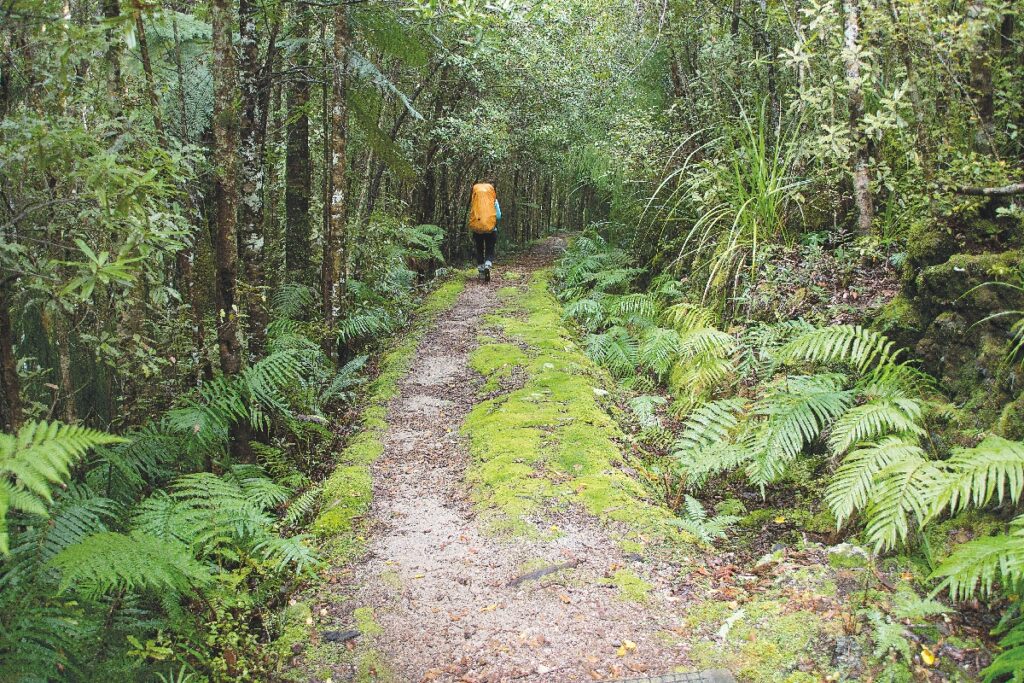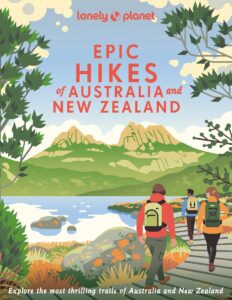
Later, sunburnt, salty-skinned and sweetly exhausted, I lie back in my tent in what must be the prettiest campsite in all of New Zealand, watching the clouds moving across the blue sky. ‘This is the life,’ I think contentedly, when my reverie is interrupted by someone shouting nearby: ‘Hey! Come back with my socks!’
The longest of New Zealand’s Great Walks, this ancient Maori route traverses across diverse terrain, from dense native forest to the wild beaches of the West Coast.
Let’s take the Heaphy track …
I’ve been descending into Heaphy Valley from the James Mackay Hut Campsite for what feels like hours, when a break in the greenery gives me a glimpse of the mouth of the Heaphy River. It should lead me to South Island’s West Coast – my goal for the day. Energised, I press on. At the bottom of the valley, temperate vegetation gives way to thickets of nikau palms and then dense rainforest, its canopy closing above my head like some enchanted tunnel. In a clearing on the bank of the Heaphy River, I come across a large gathering of hikers, resting on the ground next to Lewis Hut. I join them, but not for long, with sandflies consuming more of me than I do of my sandwich.
Crossing several swing bridges, I finally find myself on a level trail alongside the Heaphy River, the fresh, salty breeze in my face signalling the proximity of the Tasman Sea. The undergrowth opens up and I limp across a grassy clearing overlooking a beautiful lagoon, with the powerful surf battering the massive expanse of jetsam-strewn sand just beyond. My aches and blisters forgotten, I quickly put up my tiny tent, dump my gear and then spend ages padding barefoot along the damp sand, watching the waves roll in. A gaggle of freshly arrived hikers join me on the strip of sand overlooking the river, and we swim in the cold water until we turn blue.
Later, sunburnt, salty-skinned and sweetly exhausted, I lie back in my tent in what must be the prettiest campsite in all of New Zealand, watching the clouds moving across the blue sky. ‘This is the life,’ I think contentedly, when my reverie is interrupted by someone shouting nearby: ‘Hey! Come back with my socks!’
I poke my head out of my tent just in time to see a brown, speckled avian blur on legs disappear into the undergrowth, a pair of white socks clutched triumphantly in its beak.
I recognise the shouting woman as Linda, a fellow hiker I got chatting to the previous day at the Gouland Downs Hut – the snug 1930s construction where I stopped for lunch, to take advantage of the temporary shelter as the weather turned. Linda was making tea when I set up my little portable gas stove nearby, and told me that she was from Auckland, that this was her last Great Walk and that these brown flightless birds the size of a chicken, milling about outside the hut and seemingly not afraid of us, were wekas.
“You have to watch them like a hawk,” Linda explained. “They are real characters – very curious and will steal anything that’s not nailed down, particularly if it’s shiny.” Sure enough, I turned around to see one of the wekas tugging at the foil packet containing my rehydrated lunch with its beak.
I told Linda about my first day on the trail when, worn out by the relentless switchback climb from Brown Hut – the starting point – through dense podocarp forest, I didn’t make it to the campsite at Perry Saddle Hut, where hikers traditionallt stay on the first night, and instead pitched my tent at Aorere Shelter en route.
There’s something about camping alone: you are hyper-aware of every sound in the undergrowth. As the twilight thickened and the forest seemed to close in around me, I heard persistent rustling outside my tent and then watched in disbelief as one of my hiking poles slowly disappeared from view. I managed to apprehend the thief just in time.
“I thought it was a kiwi at first,” I said, since my ornithological knowledge of flightless birds is very limited.
“No, kiwis are very shy,” she explained. “And they have a long beak. Also, they’re nocturnal. You’d be really lucky to see one.”
“What brings you to New Zealand?” Linda continued. So, I told her how getting off the grid for five days and hiking and camping among pristine, unique ecosystems really appealed, and how I’ve been wanting to do this particular Great Walk for a long time.
“How do you find hiking alone?”
“Great, actually.”
After weeks of frenetic work, being alone with my thoughts while walking at my own pace through groves of ancient lichen-covered trees and across tussock downs, then pitching my tent and savouring my dinner of boil-in-a-bag chilli con carne and energy balls while the sky became a tumultuous mess of reds and golds, had been wonderfully soul-restoring.

“The only time I wished I had someone with me was when I popped down for the dip in the Saxon mountain spa”, I said. The water in the swimming hole was so frigid that the Saxon Hut staff posted the following warning by the trailhead: ‘Please take a friend with you to administer CPR when your heart stops.’ I wasn’t entirely sure whether they were kidding.
Linda never recovers her stolen socks.
The last day of the trek dawns foggy and cool. I spot an eerie sentinel in the mist on the shore of the Tasman Sea – the tiny figure of a fellow hiker. Wary of the high tide cutting off the coastal track, I take off, through thickets of nikau palms, past headlands disappearing into the mist, past pristine white-sand beaches, until the bridge across Kohaihai River deposits me at the namesake campsite – my final destination.
Later as the sea-water Cessna judders above the greenery-clad mountains and the meandering ribbon of Heaphy River, reversing the journey that took me five days in just 20 minutes, a part of me wonders if I dreamt it all.
